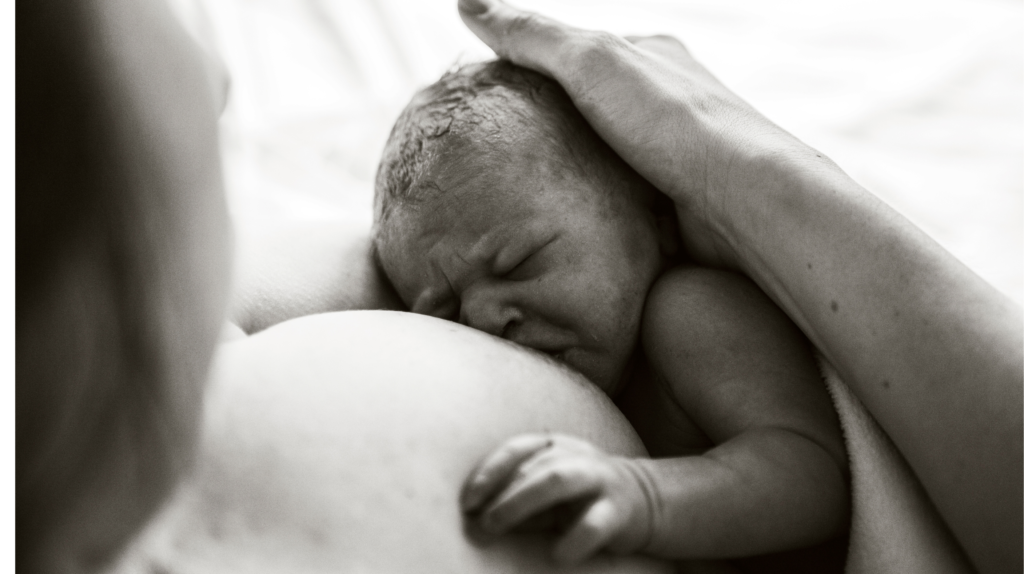
Breastfeeding your baby is a brave and wonderful decision to make. So I applaud you, momma! I trust that you know all of your reasons for wanting to breastfeed, so I won’t tout the benefits here. You’re here because your nipples hurt, your baby is fussy, and you want to know how to get a deep latch.
Are you comfortable?
Identify how you feel most comfortable. The easiest way to see what you’re doing and maintain control over your little one’s body (plus your breast) is to be sitting up, but if something else feels more comfortable to you, go for it. Make sure you have enough room to maneuver your arms and that your lap is even when your feet are flat on the floor; don’t have your lap slanting up or down. If you need to adjust either way, try sitting on a donut pillow or placing something under your feet. Have a firm rest for your back so that you aren’t slouching- this will save you the shoulder/middle back pain later.
Is little one comfortable?
This is your little one’s food and drink, so imagine their position as yours would need to be to eat and drink comfortably. When you take deep drinks of water, your upper body and neck will be in a straight line. No matter what position you are holding baby in, to make a deep latch easier, make sure his neck, shoulders, and tummy are all lined up- nothing twisting in another direction.
Is baby high enough?
You want to be comfortable, but you also don’t want baby pulling DOWN on your breast when it’s in his mouth. What to do is bring baby to your breast, not your breast to your baby. To keep your arms comfortable, place something underneath them for an arm rest that also brings baby level with your breast. (For women with big breasts, this means your exposed breast, not where your breast sits while wearing a bra.)
Can baby move his head freely?
Babies do need their head supported, but at the same time they need to be able to tilt their heads back in order to latch correctly and to get those deep gulps of milk in. If you’re supporting baby’s head with your other hand, keep your fingers at the sweet spot where the base of their head and their neck meet, right about level with their ear lobes.
Is baby relaxed?
It’s hard for babies to latch on when they are stressed and crying. If this is where your baby is right now, take time to calm him down before attempting to latch. This will save frustration for both of you.
Are you set? Okay.
Deep latch:
1. Hold your breast.
For those who were given a well-endowed chest- If your breast is large and soft, it might need to be supported while baby is still getting the hang of nursing. You have two options: 1. To keep your hand free, roll up a small rag and place it underneath your breast to keep it level with baby’s mouth. 2. Hold your breast with your free hand. Make sure to keep your fingers and thumb far away from the areola (the dark circle of skin that surrounds your nipple) because that is where your baby needs to latch.
You can cup your hand around your breast with your thumb on top (at least a 1/2 inch away from where your areola begins) and three fingers on the bottom- your third finger will be resting against your rib cage and your pinky can hang out anywhere. DO NOT SQUEEZE your breast, just hold it.
Alternatively, you can form your hand into a U with your thumb on one side (left or right) and your fingers on the other, your last finger resting against your chest. Again, DO NOT SQUEEZE. Use only enough pressure to support your breast and be comfortable.
2. Line up.
The best line to remember is that it’s breastfeeding, not nipple feeding. The next best line to remember is Nose To Nipple. Latching and nursing is ALLLL asymmetrical between baby’s mouth and your breast. This means your nipple needs to be pointing up in baby’s mouth, not centered, your baby will be taking in more of your breast underneath the areola than on top, so on and so forth- With this in mind, to keep that asymmetrical alignment, make sure your nipple is lined up directly with baby’s nose and not his mouth. That way when he opens up to start eating, your nipple will be headed in the right direction.
3. Open wide.
If you want your baby to get that deep latch that keeps you comfortable and lets her pull the milk out, you need to make her ask for it. I mean really ask. Make sure that mouth is as wide open as a yawn- that’s how wide it will need to be to take in all the breast she needs in order to eat! Sometimes all it takes is a hint of the nipple and she will be opening wide searching for the food. If your baby is a little more reluctant, try brushing your nipple across her lips a couple times or dribbling some milk onto her mouth.
4. Chin first.
When baby has his mouth open wide, you’re going to want to bring him to the breast. In real life it will be one quick motion, but here I’ll break it down in steps.
Important rule is to make sure that baby’s chin touches your breast first. We’re going for asymmetrical, with more of your breast below the nipple coming into play than your breast above the nipple. It will look like this: 1. Baby’s head is tilted back slightly with the chin jutting out rather than tucked in. 2. Baby’s chin touches the breast first, settled in beneath the areola. (Don’t worry about measuring it perfectly, just aim for not right next to the nipple). 3. With your baby’s chin anchored to the breast, roll the rest of your breast into baby’s wide open mouth, tucking the nipple in last. Snuggle baby right up against you and let him pull your nipple towards the back of his mouth, where the palate is soft and won’t hurt you.
Here is a video for a good visual. (disclaimer: this video does contain footage of breasts and nipples, just so you know.)
5. Check how it feels.
This is the part where you check if it’s working or if you have to try again. In the beginning, when it’s new for your baby, it’s not uncommon to have to unlatch and relatch several times before she gets a good deep mouthful of breast. How to know it’s working:
- You feel no pain after the first few seconds.
- There are no clicking noises (clicking means lack of suction means not a good latch).
- You can’t see much of the areola at all (the top may be somewhat visible, but the bottom shouldn’t be).
- Your breast is not being pulled out or stretched away from your body.
- Baby’s head is tilted back, with her chin deep into your breast and her nose angled away.
- Baby is showing signs of getting good milk flow.
If it isn’t working, believe me, I know how you feel. I was there too. Unlatch safely by gently inserting the tip of your pinky between baby’s mouth and your breast and try again. If you have more time, watch this excellent video!

